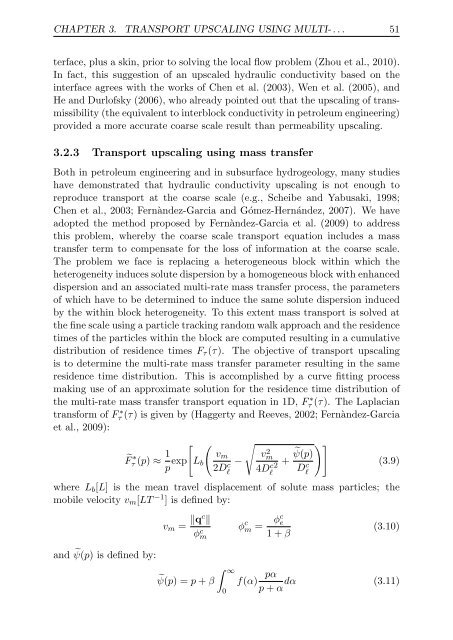Upscaling and Inverse Modeling of Groundwater Flow and Mass ...
Upscaling and Inverse Modeling of Groundwater Flow and Mass ...
Upscaling and Inverse Modeling of Groundwater Flow and Mass ...
You also want an ePaper? Increase the reach of your titles
YUMPU automatically turns print PDFs into web optimized ePapers that Google loves.
CHAPTER 3. TRANSPORT UPSCALING USING MULTI- . . . 51<br />
terface, plus a skin, prior to solving the local flow problem (Zhou et al., 2010).<br />
In fact, this suggestion <strong>of</strong> an upscaled hydraulic conductivity based on the<br />
interface agrees with the works <strong>of</strong> Chen et al. (2003), Wen et al. (2005), <strong>and</strong><br />
He <strong>and</strong> Durl<strong>of</strong>sky (2006), who already pointed out that the upscaling <strong>of</strong> transmissibility<br />
(the equivalent to interblock conductivity in petroleum engineering)<br />
provided a more accurate coarse scale result than permeability upscaling.<br />
3.2.3 Transport upscaling using mass transfer<br />
Both in petroleum engineering <strong>and</strong> in subsurface hydrogeology, many studies<br />
have demonstrated that hydraulic conductivity upscaling is not enough to<br />
reproduce transport at the coarse scale (e.g., Scheibe <strong>and</strong> Yabusaki, 1998;<br />
Chen et al., 2003; Fernàndez-Garcia <strong>and</strong> Gómez-Hernández, 2007). We have<br />
adopted the method proposed by Fernàndez-Garcia et al. (2009) to address<br />
this problem, whereby the coarse scale transport equation includes a mass<br />
transfer term to compensate for the loss <strong>of</strong> information at the coarse scale.<br />
The problem we face is replacing a heterogeneous block within which the<br />
heterogeneity induces solute dispersion by a homogeneous block with enhanced<br />
dispersion <strong>and</strong> an associated multi-rate mass transfer process, the parameters<br />
<strong>of</strong> which have to be determined to induce the same solute dispersion induced<br />
by the within block heterogeneity. To this extent mass transport is solved at<br />
the fine scale using a particle tracking r<strong>and</strong>om walk approach <strong>and</strong> the residence<br />
times <strong>of</strong> the particles within the block are computed resulting in a cumulative<br />
distribution <strong>of</strong> residence times Fτ (τ). The objective <strong>of</strong> transport upscaling<br />
is to determine the multi-rate mass transfer parameter resulting in the same<br />
residence time distribution. This is accomplished by a curve fitting process<br />
making use <strong>of</strong> an approximate solution for the residence time distribution <strong>of</strong><br />
the multi-rate mass transfer transport equation in 1D, F ∗ τ (τ). The Laplacian<br />
transform <strong>of</strong> F ∗ τ (τ) is given by (Haggerty <strong>and</strong> Reeves, 2002; Fernàndez-Garcia<br />
et al., 2009):<br />
�F ∗ τ (p) ≈ 1<br />
p exp<br />
[ (<br />
Lb<br />
vm<br />
2Dc ℓ<br />
√<br />
v<br />
−<br />
2 m<br />
4Dc ℓ 2 + � ψ(p)<br />
Dc )]<br />
ℓ<br />
(3.9)<br />
where Lb[L] is the mean travel displacement <strong>of</strong> solute mass particles; the<br />
mobile velocity vm[LT −1 ] is defined by:<br />
vm = ∥qc ∥<br />
ϕ c m<br />
<strong>and</strong> � ψ(p) is defined by:<br />
∫ ∞<br />
�ψ(p) = p + β<br />
0<br />
ϕ c m = ϕc e<br />
1 + β<br />
(3.10)<br />
f(α) pα<br />
dα (3.11)<br />
p + α


